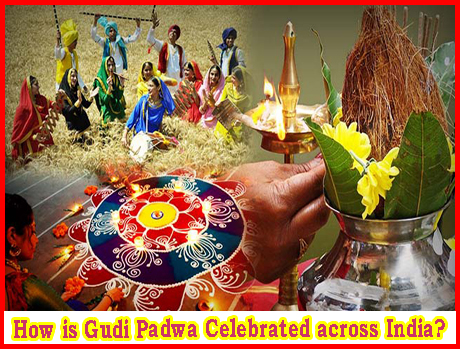 Gudi Padwa which is also known as Ugadi in Andhra Pradesh and Naba Barsha in West Bengal is celebrated throughout India with great pomp and joy. Let us take a look at the stories behind this festival and how it is celebrated across India?
Gudi Padwa which is also known as Ugadi in Andhra Pradesh and Naba Barsha in West Bengal is celebrated throughout India with great pomp and joy. Let us take a look at the stories behind this festival and how it is celebrated across India?Gudi Padwa is the first day marking the New Year according to the Hindu calendar. Gudi Padwa is the Marathi name for the actual Sanskrit name meaning Chaitra Shukla Pratipada meaning the first day of the Chaitra month that marks the bright phase of the moon.
Gudi Padwa is celebrated all over the country from North South to North East where it is known by the name of Sajibo Nongma Panba Cheiraoba in Manipur, Ugadi in Andhra Pradesh and Karnataka and Naba Barsha in West Bengal.
Historical Importance of Gudi Padwa
In Maharashtra where this festival is known as Gudi Padwa, it is celebrated as the victory march of the great Maratha ruler Chhatrapati
Shivaji. On this day the “Gudi” which is a symbol of victory. It is hoisted in every household signifying the victory of the good over the evil.
Gudi Padwa is also believed to be the beginning of the Satyug, when Shri Ramachandra was born. The divinity is believed to be at its peak on this day when the Sun rises in the morning and so the Gudi is hoisted and worshipped after sunrise to bring in the good fortunes in the house and to ward off all sins. The auspiciousness of this day is then spread in the house by hoisting the Gudi.
Significance of Gudi Padwa
This day marks a special importance for the Hindus, as according to the Puranas, Lord Brahma, created the Universe on this very day. He took the incarnation of a fish, known as Matsya incarnation to save the world from destruction. This day begins with offering
Puja to God and then cleaning the house to wash away sins. The house is then decorated with colorful Rangoli and lights and everyone in the house wear new clothes and greet each other with sweets and chocolates.
Celebrations in different parts of the country
In Karnataka there is a tradition to eat Bevu Bella that is Neem and Jaggery on this day to signify that there is both happiness and sorrow in life that has to be faced without remorse as they come.
In West Bengal, the business men on this day open their new copy of accounts after offering Puja to
Lord Ganesha. There is a festive mood everywhere and the shopkeepers offer treats to the valued customers.
In Maharashtra it is known as Gudi Padwa. The Gudi is made with a silk cloth tied to a bamboo stick and a copper pot is placed inverted on it and that is decorated with a Swastik symbol that is the symbol of holiness and spirituality of the Hindus. Marigold flowers, coconut, neem and mango leaves are also used to decorate the Gudi which is then hoisted at every house in Maharashtra.
The Gudi is believed to ward of every evil and bring in prosperity and good fortune to the house. The day starts with taking an oil bath which is believed to be very auspicious on this day. Then the entire house is decorated and special dishes are made in the Maharashtrian household. Shrikhand, a sweet dish is prepared in every house.
Beginning of the Harvest Season
Gudi Padwa also marks the beginning of the harvest season. It is the time when the mangoes ripen and are brought into the market. It is the first fruit of the year. Gudi Padwa is also a very auspicious day to
buy something new or start any new ventures like investing in a new house or buying a car etc.
Thus Gudi Padwa is celebrated all over the country with great pomp and show. People celebrate this day in their own way as they can afford. It is a day to spread love and blessings to the loved ones.
In which different ways is Gudi Padwa celebrated across India? By which other names is Gudi Padwa celebrated in other states of India? What is the significance of Gudi Padwa? Discuss here.




